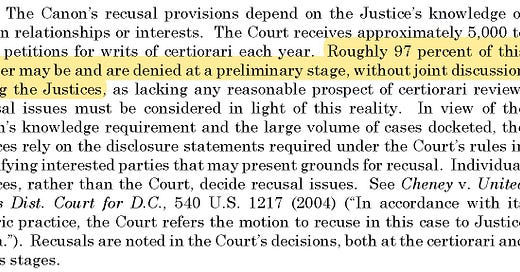Bonus 55: The Disappearing "Discuss List"
The Supreme Court's "Code of Conduct" publicly revealed an eye-opening data point about just how *few* petitions for certiorari are even *discussed* by the full Court
Welcome back to the weekly bonus content for “One First.” Although Monday’s regular newsletter will remain free for as long as I’m able to do this, much of the bonus content is behind a paywall to help incentivize those who are willing and able to support the work that goes into putting this newsletter together every week. I’m grateful to those of you who are already paid subscribers, and hope that those of you who aren’t will consider a paid subscription if your circumstances permit (or, with the holidays approaching, a gift subscription for friends, family, or Ohio State fans):
One of the central distinctions between the substance of Monday’s free issues and that of the bonus content is the personalization of the latter. For this week’s bonus content, I wanted to expand upon a point first made last week by University of Pittsburgh Professor Arthur Hellman—one of the leading experts and most careful watchers of the Supreme Court’s docket. In a post that was shared by Will Baude via the Volokh Conspiracy, Hellman flagged a remarkable public statement by the justices buried on page 11 of the commentary to the Code of Conduct that the Court issued two weeks ago:
The second sentence isn’t news. But the third (highlighted) sentence definitely is. Close Court watchers (and those who have clerked at the Court) have long known about the “discuss list”—the subset of petitions for certiorari, asking the justices to take up an appeal, that are actually discussed at the justices’ private Conferences. My favorite academic discussion is a 1990 article by Gregory Caldeira and John Wright. But academic sources have tended to only speculate about the percentage of petitions that receive the full Court’s attention, or to project from anecdotal data in individual justices’ papers (in my book, for instance, I suggested that the best evidence is that it’s “less than 20%” of the total number of petitions).
It turns out that it’s a lot less than 20%. And for reasons both documented by Hellman in his post and elaborated upon below the fold, there are some remarkable (and, in my view, troubling) consequences of having so few petitions actually debated amongst the justices prior to being denied.
For those who are not paid subscribers, the next free installment of the newsletter will drop on Monday morning. For those who are, please read on.
Keep reading with a 7-day free trial
Subscribe to One First to keep reading this post and get 7 days of free access to the full post archives.




